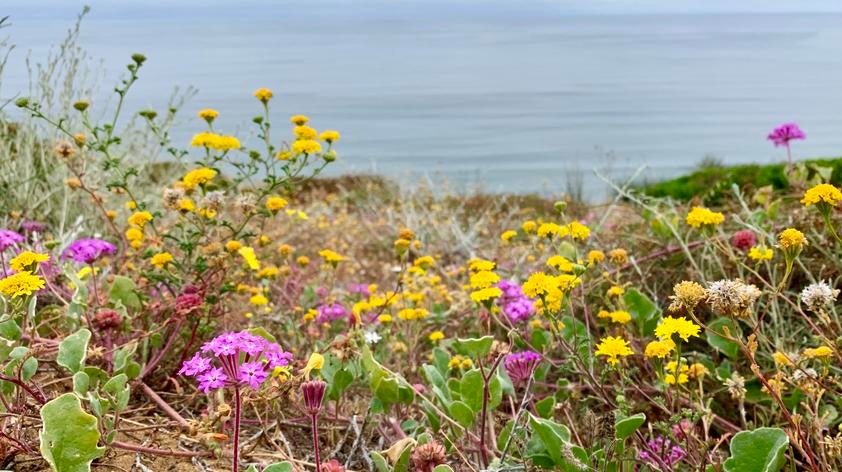
San Diego’s endemic plants: New species and living fossils
We’ve all heard that San Diego is a global “hotspot” of plant and animal diversity, but why has this come to be? How did all these species get here?
In discussing many of the rare plant species that we’ve targeted for conservation seed collections, I’ve mentioned that most are endemic to our region. In this blog I’ll discuss why we have so many endemic plant species, how they came to be here, and the importance of conserving them.
We use the word endemic to describe a species whose native range is restricted to one location. Most broadly, every species we know of is an endemic of Earth, while some species, like the American bison, are endemic to North America. We can get even more localized and say the coastal redwood is endemic to California and southern Oregon, and the short-leaved dudleya is a narrow endemic found only in a small pocket of San Diego County.
We can generally place endemic plant species into two categories, paleoendemic and neoendemic.
Paleoendemics are ancient species that evolved long ago and have survived millions of years largely unchanged. They did not evolve in our modern ecosystem. Many were widespread species whose ranges have since become much more restricted, these are also known as relict species. Often they are the only surviving members of their genus, meaning they have few existing close relatives, and their branch in their family tree is long and uninterrupted.
Coastal redwood fossils have been found throughout North America, Greenland, and Eurasia that date as far back as 180 million years ago, and show this ancient species was once much more widespread. It has survived, largely unchanged, but environmental pressures have pushed these relicts into their current restricted range, now existing within 25 miles of the Pacific Ocean in northern California and southern Oregon.
Neoendemic species are newly formed, and their origins can be traced to a relatively recent split from closely related species within our modern ecosystem. The genus Dudleya, for example, began radiating throughout western North America about 5 million years ago when there was a large shift in climate. We can trace the rise of the narrowly endemic short-leaved dudleya to a common ancestor that gave rise to many different species in our region. Neoendemics have relatively short branches on their family tree, and usually have many closely related species growing in their same region.
California, and especially Southern California, is home to a disproportionately large number of endemic species, both paleoendemics and neoendemics. This is best explained by relatively recent geological events that make our region unique.
Estimates and timelines vary, but for the sake of our discussion, let’s say roughly 5 million years ago, the uplift of the Sierra Nevada and Rocky Mountains coupled with our modern ocean current pattern, known as California Current, resulted in a dramatic climate shift, blocking summer rains and creating our present day Mediterranean climate.
Mediterranean climates are unusual, and present a unique challenge for plants. Most of the planet receives moisture in the form of rainfall and humidity during the warmest, sunniest months of the year. Because plants need water and sunlight to photosynthesize and create sugars (food), they generally grow during the summer when water and light are plentiful. Plants in Mediterranean climates must be adapted for the opposite. Little to no rain falls during our summer months, and instead, plants receive water during the coldest, darkest months of the year.
These conditions occur in only 5 regions on our planet – California, the Mediterranean basin, coastal central Chile, southwestern Australia, and the Cape region of South Africa.
Here’s why our modern flora is so special:
1 – California has a wide range of elevations, soil types, and localized climates that buffered the effect of the shifting climate and allowed many old species to avoid extinction. (Lots of paleoendemics)
2 – This same wide range of conditions, coupled with a shift to a rare and difficult climate for plants (the Mediterranean climate), resulted in numerous new niches that allowed new species to adapt and radiate throughout the region. (Lots of neoendemics)
3 – When the Mediterranean climate formed, we were geographically isolated from other similar climates. Species from other Mediterranean climates were not readily spreading into open niches. Instead, new species were formed to fill them.
There are over 50 different species of lilac (Ceanothus), over 20 occur in our county, and about 60 different species of manzanita (Arctostaphylos), 10 in our county. The diversity in these two genera radiated around 5 million years ago and they are classic examples of neoendemism.
On the other hand, there are only 2 members of the genus Adenostoma and 1 member of the genus Heteromeles. Both of these genera are old members of the rose family (Rosaceae), and split from other members in their family over 20 million years ago. Chamise (Adenostoma fasciculatum) and toyon (Heteromeles arbutifolia) are not rare in our chaparral ecosystem, they are ubiquitous, but these paleoendemics evolved well before our Mediterranean habitat was formed, and are now only found in our region.
As you can see, being a paleoendemic or neoendemic doesn’t, in and of itself, make a species rare, but endemism, especially when a range is very restricted, can make a species vulnerable to pressures caused by rapidly changing environments. Human impacts like urban development and climate change are threatening many of our endemic species. In my next blog I’ll talk about some of the rare, endangered paleoendemic and neoendemic species we’ve been working to conserve.













